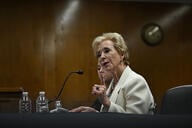You have /5 articles left.
Sign up for a free account or log in.
Many people are losing hope because of the anti-DEI policies that state legislators and governors have enacted over the past four years, as well as the Trump administration’s brutal attacks via executive orders and the U.S. Department of Education’s now-infamous Valentine’s Day Dear Colleague letter. Hopelessness also has ensued following the swift renaming and discontinuation of offices, centers and institutes, programs and professional positions on campuses. It all happened so fast—in some contexts, over four years; everywhere else, in a matter of months. A significant experience I had three decades ago gives me hope in the possibility of eventual recovery from these politicized storms that have produced such extraordinary damage to DEI initiatives in higher education.
I was born and spent the first 22 years of my life in South Georgia, a place that frequently experiences violent hurricanes and tornadoes. I have seen entire communities wiped out within minutes. In July 1994, just six weeks before the start of my freshman year in college, Tropical Storm Alberto brought torrential rains to Albany, Ga. The National Weather Service reports that more than 30 people died, nearly 50,000 residents were forced to evacuate their homes and over 18,000 structures were completely lost. Many of those buildings were at Albany State, a historically Black university located along the Flint River, which flooded during the storm. Nineteen of its 34 buildings were destroyed beyond repair and ultimately demolished.
Somehow, our fall quarter miraculously started on time. Instead of residence halls, most students in my first-year class moved into mobile homes on campus; dump trucks were scooping massive quantities of mud and recovery crews were still assembling modular units where we would sleep on the day I arrived. There was so much mud. The mess was widespread—everywhere, in fact.
For years, many classrooms and offices were located in trailers. Despite the chaos and abundance of annoying mud everywhere at Albany State, there was hope. As my family and I drove into campus for move-in day, I remember seeing a huge banner on one of the few surviving buildings that simply read, “Unsinkable.” That one word became an inspirational chant and declaration that still pervades the institution, now more than 30 years later.
The flood took so much from my beloved alma mater, but recovery efforts, which required tremendous reliance on the federal government, resulted in a more modernized campus with attractive new facilities that are atypical for most HBCUs due to state and federal funding inequities. Because of what I witnessed firsthand during my four undergraduate years, as well as in the aftermath of numerous other calamitous weather crises that occurred throughout my youth, I know that communities can rebuild homes and structures that are more solid, attractive and high-tech than what previously existed. Even still, a sense of community, family heirlooms and, in some instances, the lives of people and pets are lost. No amount of federal aid can restore those things.
While the context and circumstances are different, living through this disastrous moment in American higher education because of, but not limited to, the politicized teardown of DEI is familiar to me. Put differently, I have lived through and witnessed recovery from many tragic storms.
That does not make it any less distressing. But my four-year undergraduate experience taught me how to envision possibilities beyond the daily inescapability of mud, debris and devastation. When I arrived at Albany State as an 18-year-old freshman, rebuilding had not yet started. The institution instead was working as hard as it could with the resources it had at the time to educate, house and serve us. That is where many contemporary college and university campuses are at this very moment as it pertains to DEI.
Understandably, many students and employees who are most affected by the abandonment of institutional commitments to DEI only have the capacity to survive this catastrophic moment; they are not yet able to begin recovery work. The unavailability of federal, state and institutional resources makes it even less possible for most people to think about the next iteration of DEI efforts on campuses.
Notwithstanding, hope for something better—even if we do not know when that something better will become available—could be the one and only thing that sustains those of us who are truly committed to DEI. To be sure, I do not believe that hope alone will be enough—coalitions, elections, stock taking and documentation of harm, fundraising, activism, institutional and governmental accountability, and sophisticated strategizing are also required.
Right now, there is so much mud. The mess is widespread—everywhere, in fact. Like Albany State, the beautiful HBCU that still stands strong more than 30 years after its neighboring Flint River flooded, DEI in higher education is unsinkable. I have no choice but to believe this, and I will continue doing all I can to achieve this outcome for colleges, universities and our democracy.


